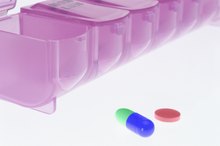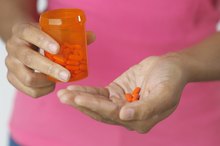List of Anti-Depression Medications
Depression is an affective mental health disorder that involves feelings of sadness and depressed mood that can exist for several months or years 3. Antidepressants, medicines that physicians prescribe to treat depression, boost brain-communicating chemicals known as neurotransmitters, which increases communication among neurons or nerve cells in the brain. Antidepressant drugs are categorized according to which chemical(s) that they act on in the brain; specifically, the neurotransmitters affected by antidepressants are norepinephrine, dopamine and serotonin. Thus, a physician will select from these different types to treat an individual’s depression.
If you are experiencing serious medical symptoms, seek emergency treatment immediately.
SSRIs
According to Medicine Net, selective serotonin reuptake inhibitors (SSRIs) are the most prescribed type of antidepressants and produce less side effects than the older medications. They work by increasing serotonin; specifically, they inhibit the reabsorption of serotonin so that more serotonin is present to elevate, affect and promote positive feelings. Examples of this classification are Lexapro, Zoloft, Paxil and Prozac.
SNRIs
Can L-Tyrosine Be Used With Prozac?
Learn More
Serotonin and norepinephrine reuptake inhibitors (SNRIs) stop the reabsorption of norepinephrine and serotonin and as a result these neurotransmitter levels decrease at a slower rate, which helps to stabilize mood. Sample medications of this type include Effexor, Cymbalta and Pristiq. These antidepressants produce fewer side effects in comparison to older groups of medications.
MAOIs and Tricyclics
The last two categories of antidepressants, MAOIs and tricyclics, are the old generation of antidepressants. Monoamine oxidase inhibitors, or MAOIs, were discovered in 1952, however, they are not used frequently today because of the seriousness of their side effects and interactions with other medications and food. These drugs inhibit the enzyme, monoamine oxidase, which then increases levels of the neurotransmitters. Examples of MAOI’s are Nardil, Parnate and Marplan.
Tricyclics drugs inhibit the reabsorption of all three discussed neurotransmitters in the brain--serotonin, norepinephrine and dopamine. Unfortunately, this group is similar to MAOIs in that it, too, is an older antidepressant and has many serious side effects; for example, an individual's blood pressure and heart rate can be affected. Some sample brands include Adaptin, Elavil, Norpramin, Endep and Sinequan.
- The last two categories of antidepressants, MAOIs and tricyclics, are the old generation of antidepressants.
Related Articles
References
- Anti-Depressants Online
- National Library of Medicine
- Health.com
- U.S. Food and Drug Administration. Celexa (citalopram hydrobromide).
- Moore TJ, Mattison DR. Adult Utilization of Psychiatric Drugs and Differences by Sex, Age, and Race. JAMA Intern Med. 2017;177(2):274-275. doi:10.1001/jamainternmed.2016.7507
- Pratt LA, Brody DJ, Gu Q. Antidepressant Use Among Persons Aged 12 and Over: United States, 2011–2014. NCHS data brief, no 283. Centers for Disease Control and Prevention. Updated August 15, 2017.
- Olfson M, Marcus SC. National Patterns in Antidepressant Medication Treatment. Arch Gen Psychiatry. 2009;66(8):848-856. doi:10.1001/archgenpsychiatry.2009.81
- Camilleri M. Serotonin in the gastrointestinal tract. Curr Opin Endocrinol Diabetes Obes. 2009;16(1):53-59. doi:10.1097/med.0b013e32831e9c8e
- Santarsieri D, Schwartz T. Antidepressant efficacy and side-effect burden: A quick guide for clinicians. Drug Context. 2015;4:212290. doi:10.7573/dic.212290
- U.S. Food and Drug Administration. Celexa (citalopram hydrobromide).
- U.S. Food & Drug Administration. FDA: Don’t Leave Childhood Depression Untreated. Updated September 10, 2014.
- Higgins A, Nash M, Lynch AM. Antidepressant-associated sexual dysfunction: Impact, effects, and treatment. Drug Healthc Patient Saf. 2010;2:141-150. doi:10.2147/DHPS.S7634
- U.S. Food and Drug Administration. Effexor (venlafaxine hydrochloride) tablets. Updated November 2011.
- Kang SG, Park YM, Lee HJ, Yoon B. Duloxetine-Induced Liver Injury in Patients with Major Depressive Disorder. Psychiatry Investig. 2011;8(3):269-271. doi:10.4306/pi.2011.8.3.269
- Philip NS, Carpenter LL, Tyrka AR, Price LH. Pharmacologic approaches to treatment resistant depression: A re-examination for the modern era. Expert Opin Pharmacother. 2010;11(5):709-722. doi:10.1517/14656561003614781
- Yasin W, Ahmed SI, Gouthro RV. Does Bupropion Impact More than Mood? A Case Report and Review of the Literature. Cureus. 2019;11(3):e4277. doi:10.7759/cureus.4277
Writer Bio
A.M. Tacon is an associate professor of health at Texas Tech University. Her research interests include psychosocial factors in cancer, complementary therapies and stress reduction in individuals with cancer. Dr. Tacon runs mindfulness-based stress reduction programs for women with breast cancer, which is based on various forms of mindfulness meditation.









